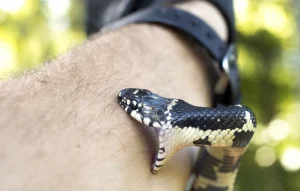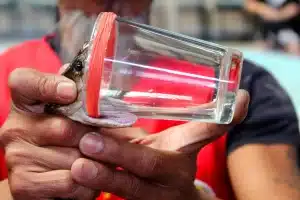Avoiding Snakebites in Thailand
A Guide to Avoiding Snakebites in Thailand and Southeast Asia
In the diverse landscapes of Thailand and other Southeast Asian countries, encountering snakes, including venomous species, is a possibility. This guide provides practical advice to minimise the risk of snakebites and ensure safe interactions with these often misunderstood creatures.
Introduction to Snakebite Prevention
The significance of preventing snakebites is paramount due to the serious health risks they pose. Annually, snakebites affect thousands globally, leading to critical health issues and fatalities. Education about snake behaviour, habitat preferences, and understanding the difference between venomous and non-venomous species is vital in reducing snakebite incidents and fostering safer human-snake coexistence.

Understanding Snake Behaviour and Habitat
Familiarise yourself with common snake species in your area. In Southeast Asia, including Thailand, venomous snakes like cobras, green pit vipers, Malayan Pit Vipers, and Kraits are primarily nocturnal but can also be active during the day.
Habitats of Venomous Snakes
The venomous snakes of this region are highly adaptive and can occupy many habitats, which provide the perfect balance between cover, prey, and environmental conditions. Many species can be found hunting small mammals, birds and reptiles on the ground. However, many are skilled climbers, living in trees and low vegetation. Preferred habitats include grasslands and scrublands. They also prefer grasslands and open woodlands. They offer both sunlight and shade and enough ground cover to hide and ambush prey.
These venomous snakes may be versatile, but they avoid dense rainforests where the canopy is so thick that it limits visibility and warmth at ground level. They also stay away from arid deserts, which lack moisture and an abundance of prey. The seasons can affect their movement and behaviour, causing them to seek refuge in burrows under debris or during periods of extreme heat or cold. Some venomous populations may be supported by human-altered environments such as agricultural fields, the edges of rural settlements or even in areas where rodents are plentiful.

Tips for Outdoor Safety
When venturing outdoors, especially in snake-prone areas, adopt these practices:
- Choose Safe Hiking and Camping Locations: Opt for areas with short grass or dirt paths, and stay on well-worn trails to avoid tall grass.
- Proper Clothing: Wear protective footwear that encloses the feet, especially when walking at night, and consider long pants to shield your legs.
- Be Vigilant Near Water and Rocks: Snakes may rest in these areas.
- Use a Flashlight at Night: Always walk with a good flashlight in dimly lit areas.
- Snake-Proofing Your Property: Remove potential snake attractants like rodents and secure gaps in fences and walls.
Encountering Snakes: Best Practices
Maintain a safe distance from snakes, at least 5 meters or more. React calmly, avoiding sudden movements or attempts to interact with the snake. Educate children on maintaining distance and identifying venomous snakes.
Understanding Snake Behaviour
Understanding snake behaviour and recognising it is important for safety, particularly in areas where there are venomous snakes. When threatened, many snakes will display specific defensive behaviours that can be used as warning signs. Cobras, for example, are known for their hood display. This is a threat posture that’s meant to intimidate predators. You need to know that cobras can still strike even if they don’t display their hood. This is especially true if they feel cornered or startled. Many venomous serpents similarly coil their bodies before striking. This helps them to launch a powerful and quick attack.
Although these warning signs may give you a clue as to the snake’s intentions and behaviour, not all snakes will behave predictably. Others may strike quickly and without warning, or flee rapidly. It is possible to reduce the chance of an accidental bite or encounter by learning the behaviours of the local snake species, including their preferred habitats and movement patterns. Understanding these cues allows people to maintain a safe range and respond calmly. This is often enough for escalation.
Snakebite First Aid and Preparedness
In the event of a snakebite, immediate action is crucial:
- Remain Calm and Immobilise the Affected Area: Avoid panicking and keep the bitten limb still.
- Seek Medical Attention Promptly: Always get to a healthcare facility as quickly as possible for proper treatment.
- Avoid Common Misconceptions: Do not cut the bite or try to suck out the venom.
- Snakebite Preparedness Kit: Carry a kit with essential first aid supplies, especially during high-risk activities like hiking, camping, and gardening.

Encouraging Snake Conservation
Understand the ecological role of snakes and promote their conservation. Respecting snake habitats and encouraging coexistence are key to protecting these important creatures.
Summary
Avoiding Snakebites in Thailand and Southeast Asia: be informed about local snake species and their behaviours, take preventive measures when outdoors, and be prepared with first aid knowledge and supplies. Respect and protect snakes to maintain ecological balance.
Remember, always explore or hike with a friend and carry a phone for emergencies, and wear appropriate clothing and carry necessary items to reduce the risk of snake encounters. By following these guidelines, you can safely enjoy the natural beauty of these regions while coexisting with their native wildlife.
